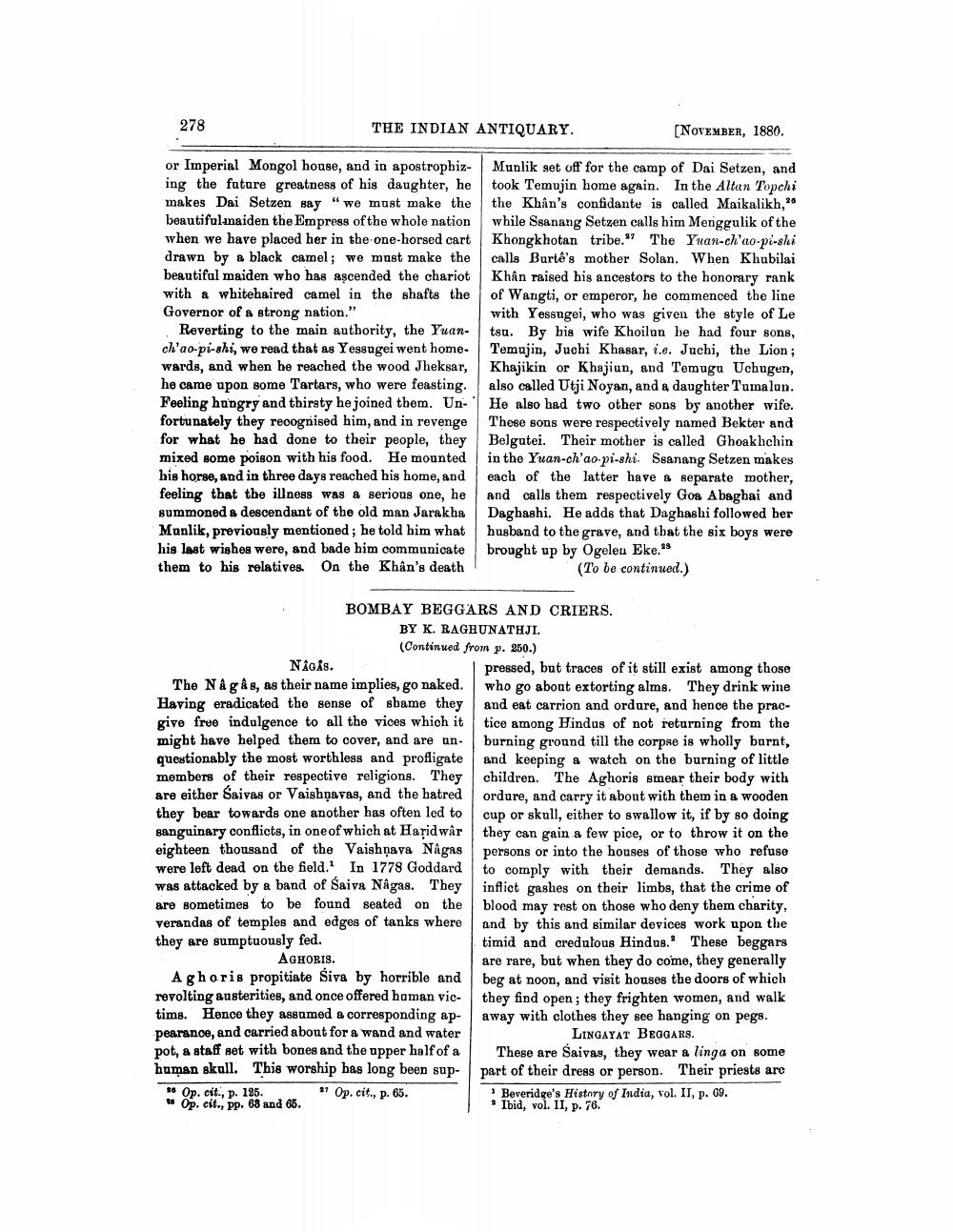________________
278
THE INDIAN ANTIQUARY.
[NOVEMBER, 1880.
or Imperial Mongol house, and in apostrophiz- Munlik get off for the camp of Dai Setzen, and ing the future greatness of his daughter, he took Temujin home again. In the Altan Topchi makes Dai Setzen say " we must make the the Khan's confidante is called Maikalikh," beautifulmaiden the Empress of the whole nation while Ssanang Setzen calls him Menggulik of the when we have placed her in the one-horsed cart Khongkhotan tribe. The Yuan-ch'ao-pi-shi drawn by a black camel; we must make the calls Burtê's mother Solan. When Khubilai beautiful maiden who has ascended the chariot Khân raised his ancestors to the honorary rank with a whitehaired camel in the shafts the of Wangti, or emperor, he commenced the line Governor of a strong nation."
with Yessugei, who was given the style of Le Reverting to the main authority, the Yuan- tsu. By his wife Khoilun he had four sons, ch'ao-pi-shi, we read that as Yessagei went home. Temajin, Juchi Khasar, i.e. Juchi, the Lion; wards, and when he reached the wood Jheksar, Khajikin or Khajiun, and Temugu Uchugen, he came upon some Tartars, who were feasting. also called Utji Noyan, and a daughter Tumalon. Feeling hungry and thirsty he joined them. Un-| He also had two other sons by another wife. fortunately they recognised him, and in revenge These sons were respectively named Bekter and for what he had done to their people, they Belgutei. Their mother is called Ghoakhchin mixed some poison with his food. He mounted in the Yuan-ch'ao pi-shi Ssanang Setzen makes his horse, and in three days reached his home, and each of the latter have a separate mother, feeling that the illness was a serious one, he and calls them respectively Goa Abaghai and summoned a descendant of the old man Jarakha Daghashi. He adds that Daghashi followed her Manlik, previously mentioned; he told him what husband to the grave, and that the six boys were his last wishes were, and bade him communicate brought up by Ogeleu Eke." them to his relatives. On the Khan's death
(To be continued.)
BOMBAY BEGGARS AND CRIERS.
BY K. RAGHUNATHJI.
(Continued from p. 250.) Niats.
pressed, but traces of it still exist among those The Nagas, as their name implies, go naked. who go about extorting alme. They drink wine Having eradicated the sense of shame they
and eat carrion and ordure, and hence the pracgive frue indulgence to all the vices which it tice among Hindus of not returning from the might have helped them to cover, and are un. burning ground till the corpse is wholly burnt, questionably the most worthless and profligate and keeping a watch on the burning of little members of their respective religions. They children. The Aghoris smear their body with are either Saivas or Vaishṇavas, and the hatred
ordure, and carry it about with them in a wooden they bear towards one another has often led to cup or skull, either to swallow it, if by so doing sanguinary conflicts, in one of which at Haridwar they can gain a few pice, or to throw it on the eighteen thousand of the Vaishnava Nagas
persons or into the houses of those who refuse were left dead on the field. In 1778 Goddard to comply with their demands. They also was attacked by a band of Saiva Nagas. They
inflict gashes on their limbs, that the crime of are sometimes to be found seated on the blood may rest on those who deny them charity, verandas of temples and edges of tanks where and by this and similar devices work upon the they are sumptuously fed.
timid and credulous Hindus.' These beggars AGHORIS.
are rare, but when they do come, they generally Aghoris propitiate Siva by horrible and beg at noon, and visit houses the doors of which revolting austerities, and once offered human vic- they find open; they frighten women, and walk time. Hence they assumed a corresponding ap- away with clothes they see hanging on pegs. pearance, and carried about for a wand and water
LINGAYAT BEGGARS pot, a staff set with bones and the upper half of a These are Saivas, they wear a linga on some human skull. This worship has long been sup- part of their dress or person. Their priests are • Op. cit., p. 185. " Op. cit., p. 65.
Beveridge's History of India, vol. II, p. 69. * Op. cit., pp. 68 and 66.
Ibid, vol. II, p. 76.




